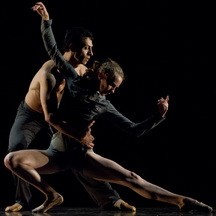
Transforming a poet’s vision into movement
In contrast to the previous program’s abstract figures on color, San Francisco Ballet’s Program 3 presents story ballets, the most powerful among them being “Francesca da Rimini,” a world premiere from the company’s resident choreographer, Yuri Possokhov, set to Tchaikovsky’s emotionally charged symphonic tone poem.
In Possokhov’s interpretation of the story of Dante’s adulterous lovers, Paolo and Francesca, the action of their lives seems to take place just inside the gates of Hell, where their worldly romance blends with their eternal punishment: they are constantly buffeted by wind. This is most clearly seen in the long pas de deux, during which Francesca is tossed, dragged and flung by her lover across his body. Joan Boada does a spectacular job partnering Maria Kotchetkova, who in turn seems to release her body completely to the momentum of her partner’s strength. Anything less than absolute submission to the tempo and gravity would not work—would suggest a volition that runs counter to the sin (and, for Dante, it is a sin) of being unable to resist desire.
This kind of partnering, which carries with it a sense of constant danger because of its difficulty, is only possible with a lithe, petite dancer with extreme flexibility. It requires a liquid but undeniable strength and impeccable timing from both dancers.
Taras Domitro danced wonderfully the role of Gianciotto, though he is much too handsome to portray Francesca’s cuckold husband, Gianciotto Malatesta.
There are eight other characters in the ballet: five court women and three Shades. The role of the women is unclear: at times they seem to be reflections of Francesca but that begs the questions of how they are reflections and why there are no reflections of Paolo. The three Shades—Jeremy Rucker, Quinn Wharton, Luke Willis—are a more mysterious element. Dressed in shaded gray leotards, they appear to be statues or eerie corpses. They are responsible for creating the sense of conflating death-in-life and life-in-death that is so interesting in this ballet’s interpretation of Dante’s story.
From tone poem to limmerick
Helgi Tomasson’s “Trio”—set to Tchaikovsky’s “Souvenir de Florence”—is primarily an abstract piece for soloists and ensemble. But the second movement, Adagio cantabile, creates a parable of two men and a woman. The adagio begins with two lovers, Sarah van Patten and Tiit Helimets, in a gorgeous pas de deux which displayed van Patten’s fabulously strong back and lyric arm movements: she simply melts into the surrounding air everywhere. In the midst of their tender love, the two are joined by a dark man, Vito Mazzeo, whom the program describes as “a figure of death.” He insinuates himself between the two dancers, eventually taking the woman offstage, his hand over her eyes.
The program closed with the playful “Le Carnaval des Animaux”—choreographer Alexei Ratmansky’s inventive setting of Camille Saint-Saëns’ music. A host of animals go through their furry and finny paces, from a lion (best to let sleeping lions sleep, as the ensemble discover) to a jellyfish.
All of these beastie portraits were lovable. Though Courtney Elizabeth’s Elephant and Sofiane Sylve’s Jellyfish were especially endearing. Sylve also danced a limply dying swan, which left her fishy friends in tears and the audience in smiles.
—Jaime Robles
San Francisco Ballet’s Program 3 continues until February 2625 at the War Memorial Opera House, Van Ness Avenue and Grove Street, San Francisco. For tickets and information, visit www.sfballet.org or call 415-865-2000.
Photo: San Francisco Ballet members in Ratmansky’s Le Carnaval des Animaux, Program 3. Photo by Erik Tomasson.
